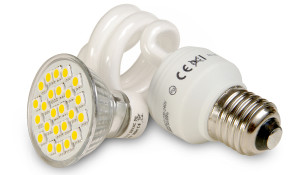 About two decades ago, the CFL lightbulb hit the [city] market and was supposed to change lighting forever. The bulbs weren’t totally round, and they didn’t look like what we had been used to illuminate rooms for decades. They had a twisted shape, took longer to get bright and sported a higher price tag. They could, however, last ten times as long as older alternatives and use about 1/4 of the wattage to get similar light quality.
About two decades ago, the CFL lightbulb hit the [city] market and was supposed to change lighting forever. The bulbs weren’t totally round, and they didn’t look like what we had been used to illuminate rooms for decades. They had a twisted shape, took longer to get bright and sported a higher price tag. They could, however, last ten times as long as older alternatives and use about 1/4 of the wattage to get similar light quality.
Eventually, it was determined that the new, energy efficient alternatives were difficult to dispose of and could harm the [city] environment due to chemicals that were contained inside.
Around when CFLs emerged as an alternative to incandescent lighting, the blue LED was discovered. The innovation of the color allowed the researchers to combine the newly created blue light emitting diode with previously created red and green LEDs and create white light. From there, a more natural color for lighting emerged that CFLs were not able to produce, and LED lighting for [city] commercial and residential interiors was born.
The invention of LEDs has been a huge leap forward for energy efficiency in [city] lighting, and it effectively made CFLs a short-term solution to bigger energy consumption and environmental issues. Though CFLS had improved on some of the inherent issues of incandescent bulbs, they still fell short of the necessary light quality. Further, the problems with safe disposal were troubling. CFLs turned out to be a bandage rather than a solution.
As LED technology has further developed, the former limitations related to price have diminished thanks to a significant decrease in out-of-pocket costs. LEDs also don’t contain the kind of harmful chemicals that are housed within CFLs, so they can be safely disposed of without requiring special procedures. Even though, at the time, CFLs represented a huge jump in the lifecycle of bulbs, LED has further expanded on that with bulbs that rate for up to 100,000 hours of use. The 10,000 hours that CFLs would remain in use was, at one point, incredibly impressive. Now, it’s a drop in the bucket.
Newer LED technologies have reduced previous objections related to cost and brightness. LEDs are no longer targeted to small areas, and it’s possible to get effective and diffuse light from a single bulb. There is now an LED bulb available for less than $20 that has the same brightness as an incandescent bulb. Additionally, T-12 or linear lighting has an LED alternative that runs around $10 per bulb and has a staying power of about 100 times its predecessor. In the 20 years that LED lighting has been on the market, it has presented options that incandescents and CFLs never had in their future.
CFLs were presented as the bulb of the future, but they turned out to only be the bulb of the decade. It wasn’t long before LED was not on the market with costs that were falling rapidly. Businesses throughout [city] can benefit from reduced electricity bills, lower maintenance cost and more environmental consciousness by making the switch. The life cycle of CFLs in general may be coming to an end.

![Choosing the Right LED Bulb Color [city]](https://8blocks.s3.amazonaws.com/eepros/blog-images/2015/03/lef-bulbs-300x146.jpg)
![Top 8 Benefits of LED Lighting [city]](https://8blocks.s3-us-west-1.amazonaws.com/eepros/2020/social.jpg)
![LED Light Bulbs, Incandescent Lamps, and Halogens — Which One Is Best? [city]](https://8blocks.s3.amazonaws.com/eepros/blog-images/2016/10/hotel-389256_640-300x200.jpg)